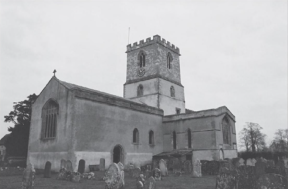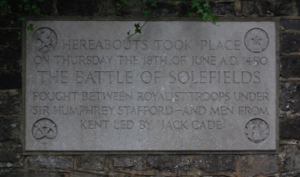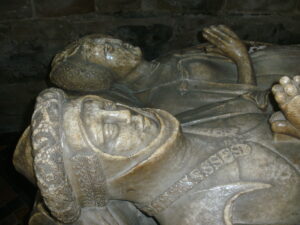Sir Humphrey Stafford
Sir Humphrey Stafford of Grafton
 Humphrey was born about 1450, the second son of Sir Humphrey Stafford (1384-1419) and Elizabeth Burdett. Humphrey became the heir when his elder brother John died in 1422.
Humphrey was born about 1450, the second son of Sir Humphrey Stafford (1384-1419) and Elizabeth Burdett. Humphrey became the heir when his elder brother John died in 1422.
You may think there are a lot of “Stafford’s” in this era and there indeed is! They are all related, in some shape or form, some closely and others distantly. It seems you are never far from a “Stafford” in this story. The Duke of Buckingham shared the same name, Humphrey Stafford was one of the kings advisors and he owned Tonbridge Castle (which may or may not have some bearing on our Humphreys demise). Another Stafford who was a kings advisor, was John Stafford, the Arch Bishop of Canterbury and Lord Chancellor.
Humphrey got married to Eleanor (Alianore) of Aylesbury in 1424 and they had many children, Richard, Humphrey Thomas, Ralph, John, Anne & Joyce.
In 1436 he became governor of Calais. In 1447, he obtained a license for a perpetual chantry in the parish Church in Bromsgrove.
In 1448, which makes this story a bit more juicy, there was an ongoing feud between Humphrey and Sir Robert Harcourt. Harcourt with his protector the Duke of Suffolk and Humprhey with the “Stafford’s” behind him clashed in May of this year. The story goes that the two men with their retinues, who already harboured a grudge against one another, passed each other near Coventry. Humphreys son Richard, not able to contain himself after words were spoken, attacked Robert. Robert hit him on the head with his sword (possibly the pommel), but Richard drew a knife on Richard only to be killed by someone in Roberts Retinue. Humphrey, seeing his son being attacked, came to his aid and a melee ensued. Humphrey was knocked off his horse and two of Harcourt’s retinue died ( I like to think the one who killed Richard was one of the dead, but this is just a thought and not based on fact).

Humphrey, used his connections to his advantage and got Harcourt arrested for his sons murder. Harcourt was incarcerated in Chester Castle awaiting his trial when his protector, the Duke of Suffolk, got him released (although some think it might have been the Queen). This family feud did not end here. Emboldened by the banishment of the Duke of Suffolk, Humphrey took the opportunity to strike at Harcourt. Humphrey and a force of up to 200 men (sources differ hence “up to”), went after Robert. Robert must have got wind of the impending attack as he ran to the church and barricaded himself in the tower in Stanton Harcourt, Oxfordshire. Reports of 1,000 arrows being shot at the tower and a small fire in the room below where Robert had hidden, but Robert survived and the attack was called off after about 6 hours, leaving one of Harcourts retinue dead. With the rebellion in the South East just starting, the King decided that he needed all his men and that he would deal with the situation after the crisis.

When the rebels dispersed from Blackheath, the king decided to give chase and one of the first to catch up with the rebels was Sir Humphrey and his (brother/cousin/2nd cousin sources cant be certain) William Stafford just outside Sevenoaks on the road to Tonbridge. Humphrey and William walked into a trap and were massacred. This short battle is referred to the Battle of Solefields, (an area now on the extents of the Sevenoaks conurbation), there is a memorial plaque in the vicinity of the Battle.
With this victory, it emboldened the rebels to even greater expectations, and perhaps without it, they may have dispersed and the rebellion would have petered out.

Humphrey and William’s bodies were taken away and Humphries body was taken back to Bromsgrove and laid to rest in the church of St John. Today you can still see his and Eleanor’s tomb with their alabaster effigies on top.
As a side note, the family feud with the Harcourts continued until one of Humphrey’s sons killed Robert some 20 years later.
